20 Tourism Consumer Behaviour and Insight (L5)
VerifiedAdded on 2023/01/19
|14
|3941
|35
AI Summary
Hi! On the Research Project i need to be written 6000-6500 words.
Contribute Materials
Your contribution can guide someone’s learning journey. Share your
documents today.
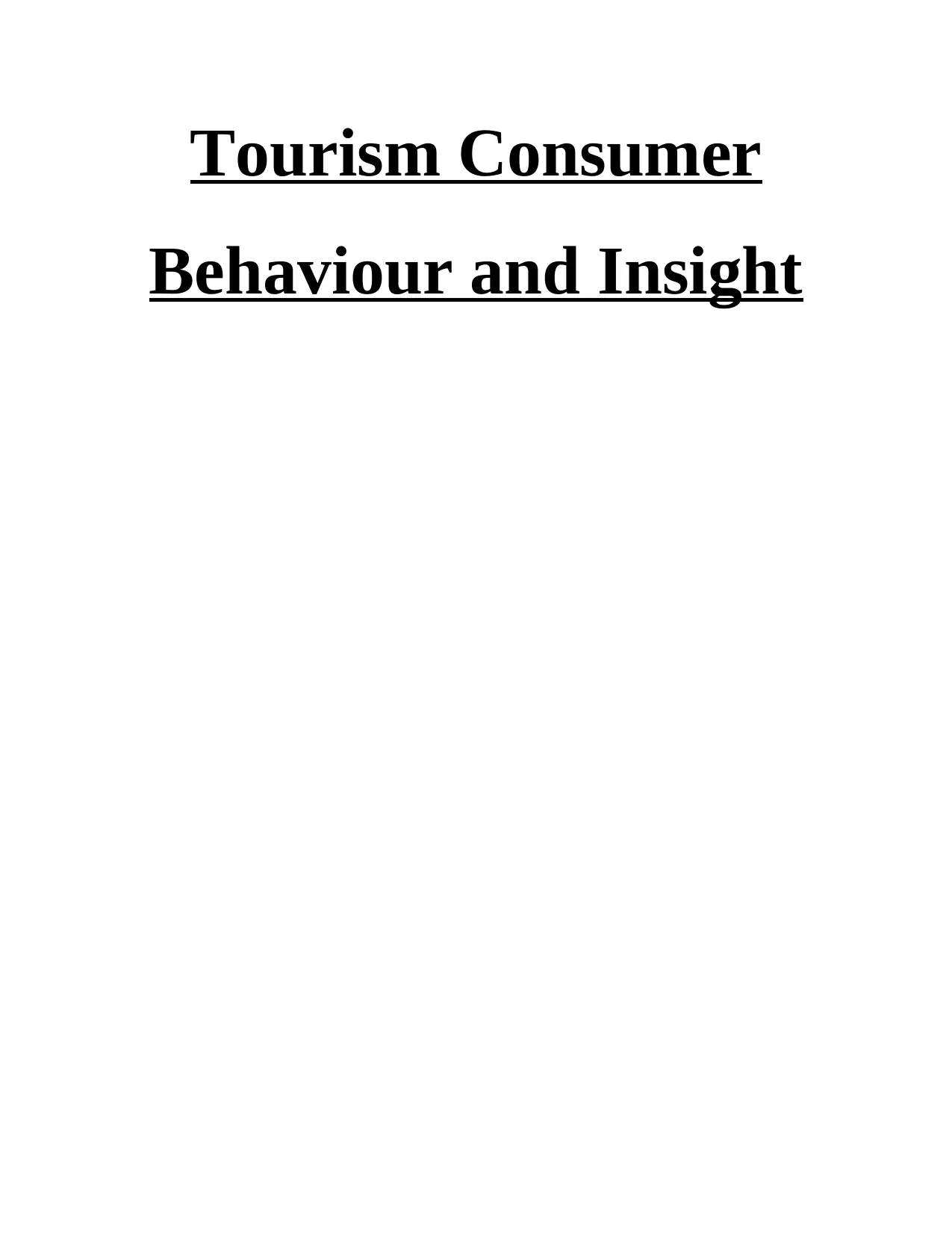
Tourism Consumer
Behaviour and Insight
Behaviour and Insight
Secure Best Marks with AI Grader
Need help grading? Try our AI Grader for instant feedback on your assignments.
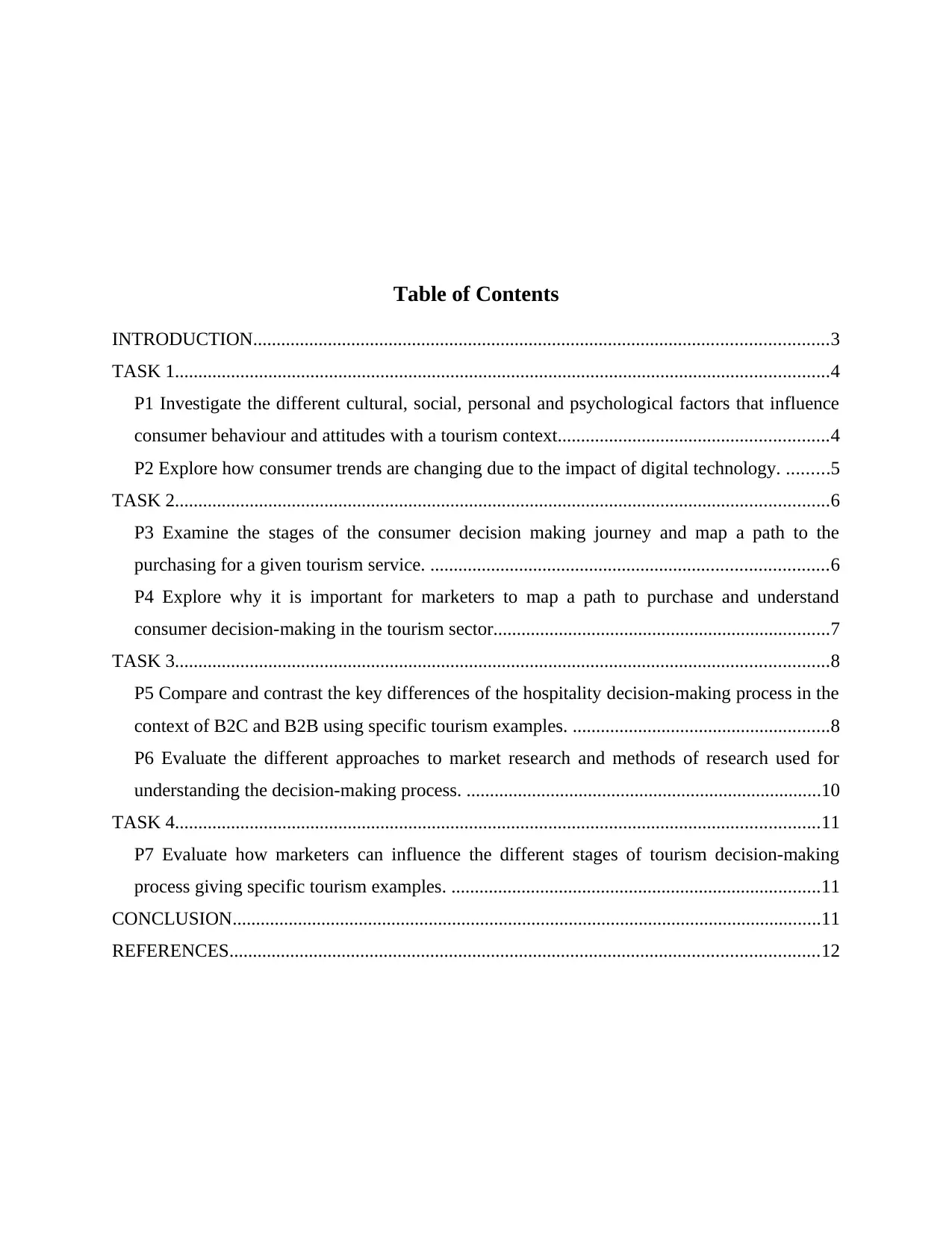
Table of Contents
INTRODUCTION...........................................................................................................................3
TASK 1............................................................................................................................................4
P1 Investigate the different cultural, social, personal and psychological factors that influence
consumer behaviour and attitudes with a tourism context..........................................................4
P2 Explore how consumer trends are changing due to the impact of digital technology. .........5
TASK 2............................................................................................................................................6
P3 Examine the stages of the consumer decision making journey and map a path to the
purchasing for a given tourism service. .....................................................................................6
P4 Explore why it is important for marketers to map a path to purchase and understand
consumer decision-making in the tourism sector........................................................................7
TASK 3............................................................................................................................................8
P5 Compare and contrast the key differences of the hospitality decision-making process in the
context of B2C and B2B using specific tourism examples. .......................................................8
P6 Evaluate the different approaches to market research and methods of research used for
understanding the decision-making process. ............................................................................10
TASK 4..........................................................................................................................................11
P7 Evaluate how marketers can influence the different stages of tourism decision-making
process giving specific tourism examples. ...............................................................................11
CONCLUSION..............................................................................................................................11
REFERENCES..............................................................................................................................12
INTRODUCTION...........................................................................................................................3
TASK 1............................................................................................................................................4
P1 Investigate the different cultural, social, personal and psychological factors that influence
consumer behaviour and attitudes with a tourism context..........................................................4
P2 Explore how consumer trends are changing due to the impact of digital technology. .........5
TASK 2............................................................................................................................................6
P3 Examine the stages of the consumer decision making journey and map a path to the
purchasing for a given tourism service. .....................................................................................6
P4 Explore why it is important for marketers to map a path to purchase and understand
consumer decision-making in the tourism sector........................................................................7
TASK 3............................................................................................................................................8
P5 Compare and contrast the key differences of the hospitality decision-making process in the
context of B2C and B2B using specific tourism examples. .......................................................8
P6 Evaluate the different approaches to market research and methods of research used for
understanding the decision-making process. ............................................................................10
TASK 4..........................................................................................................................................11
P7 Evaluate how marketers can influence the different stages of tourism decision-making
process giving specific tourism examples. ...............................................................................11
CONCLUSION..............................................................................................................................11
REFERENCES..............................................................................................................................12
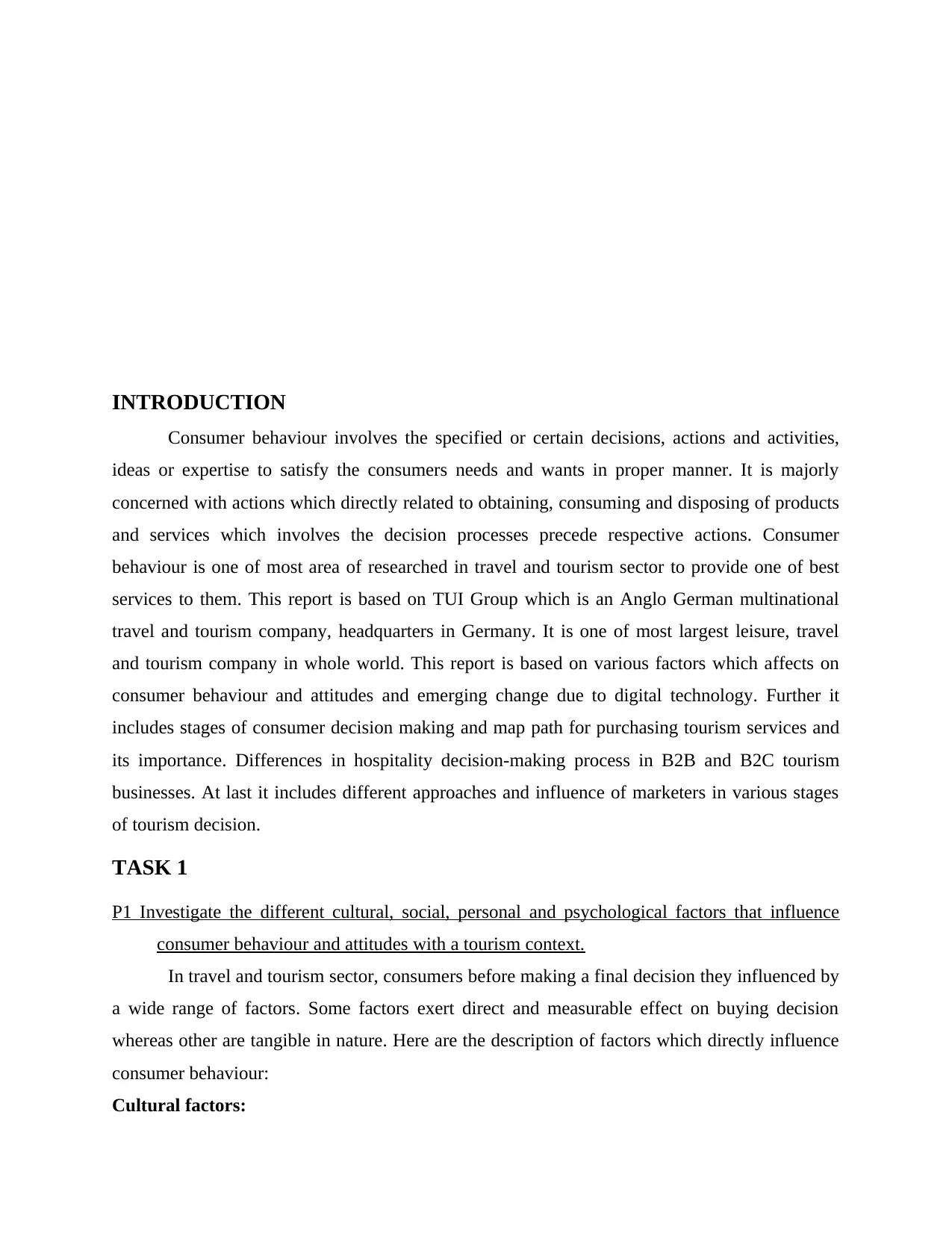
INTRODUCTION
Consumer behaviour involves the specified or certain decisions, actions and activities,
ideas or expertise to satisfy the consumers needs and wants in proper manner. It is majorly
concerned with actions which directly related to obtaining, consuming and disposing of products
and services which involves the decision processes precede respective actions. Consumer
behaviour is one of most area of researched in travel and tourism sector to provide one of best
services to them. This report is based on TUI Group which is an Anglo German multinational
travel and tourism company, headquarters in Germany. It is one of most largest leisure, travel
and tourism company in whole world. This report is based on various factors which affects on
consumer behaviour and attitudes and emerging change due to digital technology. Further it
includes stages of consumer decision making and map path for purchasing tourism services and
its importance. Differences in hospitality decision-making process in B2B and B2C tourism
businesses. At last it includes different approaches and influence of marketers in various stages
of tourism decision.
TASK 1
P1 Investigate the different cultural, social, personal and psychological factors that influence
consumer behaviour and attitudes with a tourism context.
In travel and tourism sector, consumers before making a final decision they influenced by
a wide range of factors. Some factors exert direct and measurable effect on buying decision
whereas other are tangible in nature. Here are the description of factors which directly influence
consumer behaviour:
Cultural factors:
Consumer behaviour involves the specified or certain decisions, actions and activities,
ideas or expertise to satisfy the consumers needs and wants in proper manner. It is majorly
concerned with actions which directly related to obtaining, consuming and disposing of products
and services which involves the decision processes precede respective actions. Consumer
behaviour is one of most area of researched in travel and tourism sector to provide one of best
services to them. This report is based on TUI Group which is an Anglo German multinational
travel and tourism company, headquarters in Germany. It is one of most largest leisure, travel
and tourism company in whole world. This report is based on various factors which affects on
consumer behaviour and attitudes and emerging change due to digital technology. Further it
includes stages of consumer decision making and map path for purchasing tourism services and
its importance. Differences in hospitality decision-making process in B2B and B2C tourism
businesses. At last it includes different approaches and influence of marketers in various stages
of tourism decision.
TASK 1
P1 Investigate the different cultural, social, personal and psychological factors that influence
consumer behaviour and attitudes with a tourism context.
In travel and tourism sector, consumers before making a final decision they influenced by
a wide range of factors. Some factors exert direct and measurable effect on buying decision
whereas other are tangible in nature. Here are the description of factors which directly influence
consumer behaviour:
Cultural factors:
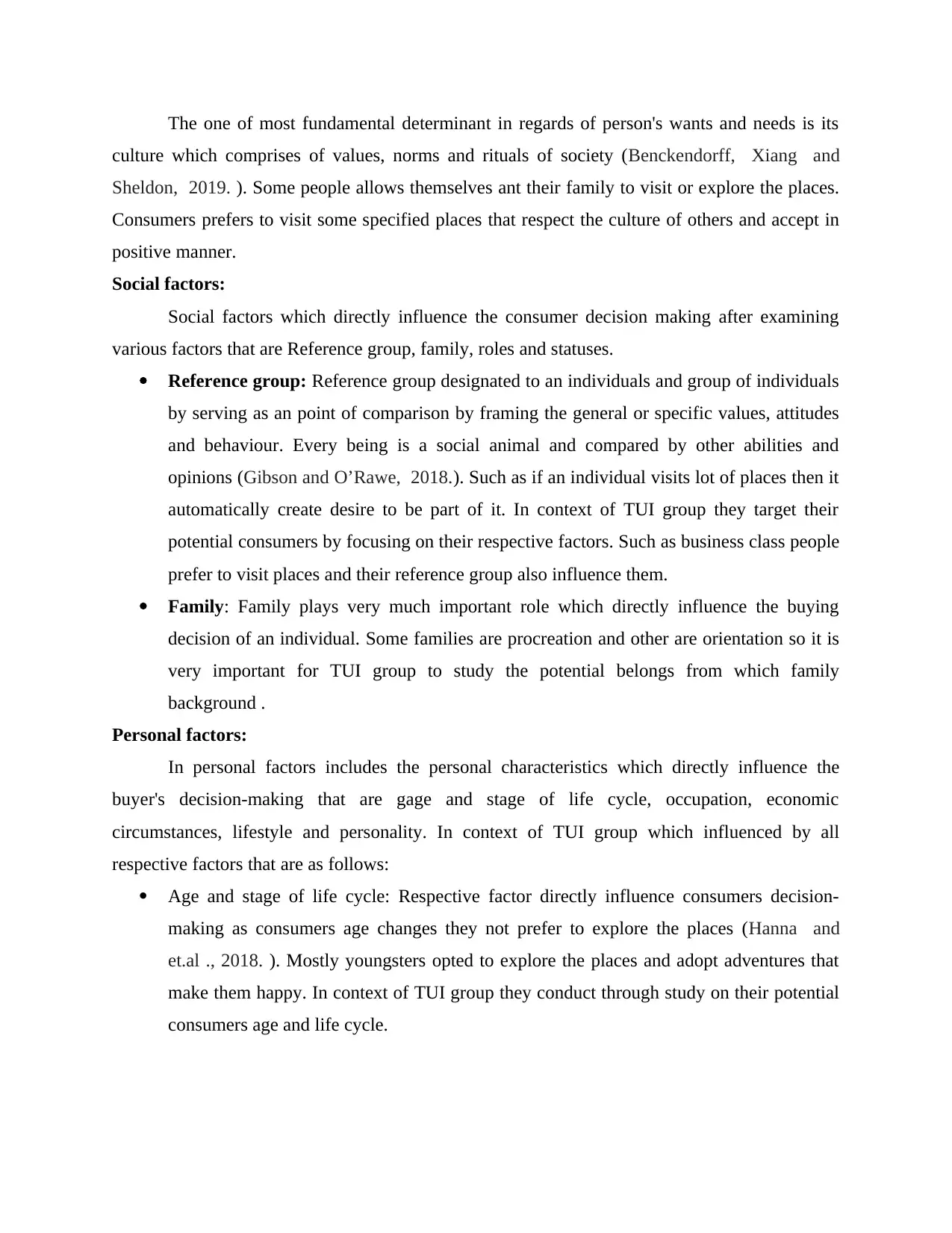
The one of most fundamental determinant in regards of person's wants and needs is its
culture which comprises of values, norms and rituals of society (Benckendorff, Xiang and
Sheldon, 2019. ). Some people allows themselves ant their family to visit or explore the places.
Consumers prefers to visit some specified places that respect the culture of others and accept in
positive manner.
Social factors:
Social factors which directly influence the consumer decision making after examining
various factors that are Reference group, family, roles and statuses.
Reference group: Reference group designated to an individuals and group of individuals
by serving as an point of comparison by framing the general or specific values, attitudes
and behaviour. Every being is a social animal and compared by other abilities and
opinions (Gibson and O’Rawe, 2018.). Such as if an individual visits lot of places then it
automatically create desire to be part of it. In context of TUI group they target their
potential consumers by focusing on their respective factors. Such as business class people
prefer to visit places and their reference group also influence them.
Family: Family plays very much important role which directly influence the buying
decision of an individual. Some families are procreation and other are orientation so it is
very important for TUI group to study the potential belongs from which family
background .
Personal factors:
In personal factors includes the personal characteristics which directly influence the
buyer's decision-making that are gage and stage of life cycle, occupation, economic
circumstances, lifestyle and personality. In context of TUI group which influenced by all
respective factors that are as follows:
Age and stage of life cycle: Respective factor directly influence consumers decision-
making as consumers age changes they not prefer to explore the places (Hanna and
et.al ., 2018. ). Mostly youngsters opted to explore the places and adopt adventures that
make them happy. In context of TUI group they conduct through study on their potential
consumers age and life cycle.
culture which comprises of values, norms and rituals of society (Benckendorff, Xiang and
Sheldon, 2019. ). Some people allows themselves ant their family to visit or explore the places.
Consumers prefers to visit some specified places that respect the culture of others and accept in
positive manner.
Social factors:
Social factors which directly influence the consumer decision making after examining
various factors that are Reference group, family, roles and statuses.
Reference group: Reference group designated to an individuals and group of individuals
by serving as an point of comparison by framing the general or specific values, attitudes
and behaviour. Every being is a social animal and compared by other abilities and
opinions (Gibson and O’Rawe, 2018.). Such as if an individual visits lot of places then it
automatically create desire to be part of it. In context of TUI group they target their
potential consumers by focusing on their respective factors. Such as business class people
prefer to visit places and their reference group also influence them.
Family: Family plays very much important role which directly influence the buying
decision of an individual. Some families are procreation and other are orientation so it is
very important for TUI group to study the potential belongs from which family
background .
Personal factors:
In personal factors includes the personal characteristics which directly influence the
buyer's decision-making that are gage and stage of life cycle, occupation, economic
circumstances, lifestyle and personality. In context of TUI group which influenced by all
respective factors that are as follows:
Age and stage of life cycle: Respective factor directly influence consumers decision-
making as consumers age changes they not prefer to explore the places (Hanna and
et.al ., 2018. ). Mostly youngsters opted to explore the places and adopt adventures that
make them happy. In context of TUI group they conduct through study on their potential
consumers age and life cycle.
Secure Best Marks with AI Grader
Need help grading? Try our AI Grader for instant feedback on your assignments.
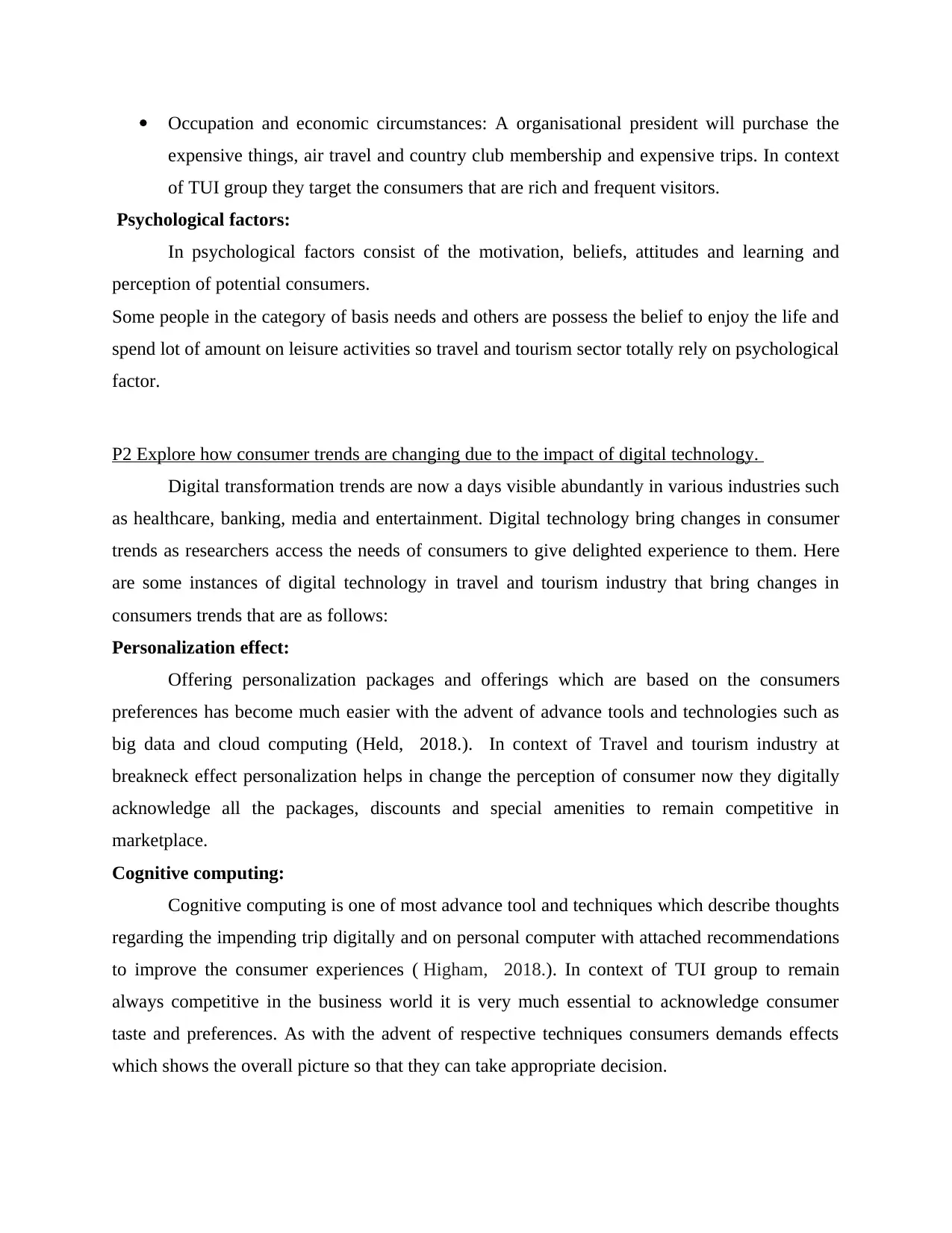
Occupation and economic circumstances: A organisational president will purchase the
expensive things, air travel and country club membership and expensive trips. In context
of TUI group they target the consumers that are rich and frequent visitors.
Psychological factors:
In psychological factors consist of the motivation, beliefs, attitudes and learning and
perception of potential consumers.
Some people in the category of basis needs and others are possess the belief to enjoy the life and
spend lot of amount on leisure activities so travel and tourism sector totally rely on psychological
factor.
P2 Explore how consumer trends are changing due to the impact of digital technology.
Digital transformation trends are now a days visible abundantly in various industries such
as healthcare, banking, media and entertainment. Digital technology bring changes in consumer
trends as researchers access the needs of consumers to give delighted experience to them. Here
are some instances of digital technology in travel and tourism industry that bring changes in
consumers trends that are as follows:
Personalization effect:
Offering personalization packages and offerings which are based on the consumers
preferences has become much easier with the advent of advance tools and technologies such as
big data and cloud computing (Held, 2018.). In context of Travel and tourism industry at
breakneck effect personalization helps in change the perception of consumer now they digitally
acknowledge all the packages, discounts and special amenities to remain competitive in
marketplace.
Cognitive computing:
Cognitive computing is one of most advance tool and techniques which describe thoughts
regarding the impending trip digitally and on personal computer with attached recommendations
to improve the consumer experiences ( Higham, 2018.). In context of TUI group to remain
always competitive in the business world it is very much essential to acknowledge consumer
taste and preferences. As with the advent of respective techniques consumers demands effects
which shows the overall picture so that they can take appropriate decision.
expensive things, air travel and country club membership and expensive trips. In context
of TUI group they target the consumers that are rich and frequent visitors.
Psychological factors:
In psychological factors consist of the motivation, beliefs, attitudes and learning and
perception of potential consumers.
Some people in the category of basis needs and others are possess the belief to enjoy the life and
spend lot of amount on leisure activities so travel and tourism sector totally rely on psychological
factor.
P2 Explore how consumer trends are changing due to the impact of digital technology.
Digital transformation trends are now a days visible abundantly in various industries such
as healthcare, banking, media and entertainment. Digital technology bring changes in consumer
trends as researchers access the needs of consumers to give delighted experience to them. Here
are some instances of digital technology in travel and tourism industry that bring changes in
consumers trends that are as follows:
Personalization effect:
Offering personalization packages and offerings which are based on the consumers
preferences has become much easier with the advent of advance tools and technologies such as
big data and cloud computing (Held, 2018.). In context of Travel and tourism industry at
breakneck effect personalization helps in change the perception of consumer now they digitally
acknowledge all the packages, discounts and special amenities to remain competitive in
marketplace.
Cognitive computing:
Cognitive computing is one of most advance tool and techniques which describe thoughts
regarding the impending trip digitally and on personal computer with attached recommendations
to improve the consumer experiences ( Higham, 2018.). In context of TUI group to remain
always competitive in the business world it is very much essential to acknowledge consumer
taste and preferences. As with the advent of respective techniques consumers demands effects
which shows the overall picture so that they can take appropriate decision.
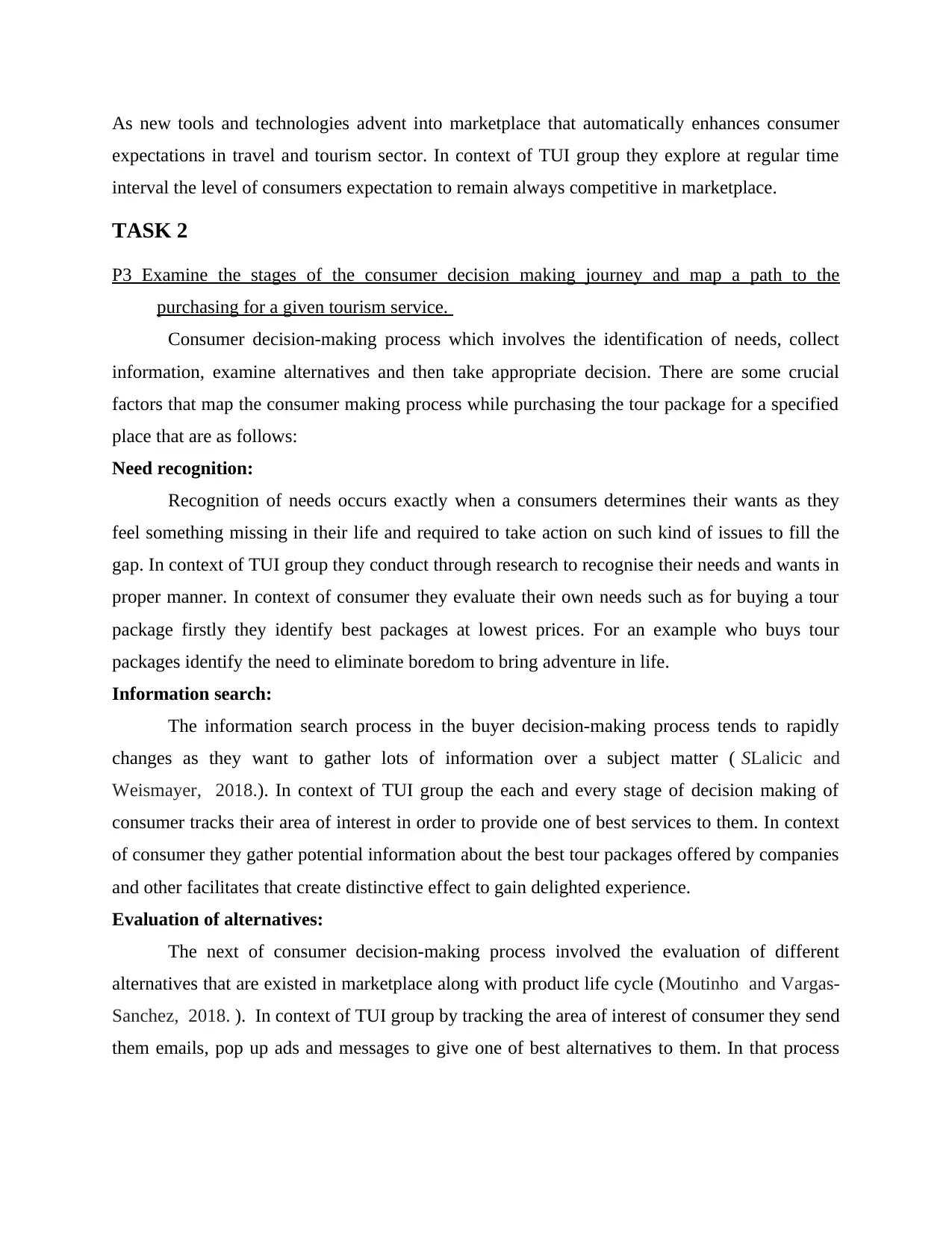
As new tools and technologies advent into marketplace that automatically enhances consumer
expectations in travel and tourism sector. In context of TUI group they explore at regular time
interval the level of consumers expectation to remain always competitive in marketplace.
TASK 2
P3 Examine the stages of the consumer decision making journey and map a path to the
purchasing for a given tourism service.
Consumer decision-making process which involves the identification of needs, collect
information, examine alternatives and then take appropriate decision. There are some crucial
factors that map the consumer making process while purchasing the tour package for a specified
place that are as follows:
Need recognition:
Recognition of needs occurs exactly when a consumers determines their wants as they
feel something missing in their life and required to take action on such kind of issues to fill the
gap. In context of TUI group they conduct through research to recognise their needs and wants in
proper manner. In context of consumer they evaluate their own needs such as for buying a tour
package firstly they identify best packages at lowest prices. For an example who buys tour
packages identify the need to eliminate boredom to bring adventure in life.
Information search:
The information search process in the buyer decision-making process tends to rapidly
changes as they want to gather lots of information over a subject matter ( SLalicic and
Weismayer, 2018.). In context of TUI group the each and every stage of decision making of
consumer tracks their area of interest in order to provide one of best services to them. In context
of consumer they gather potential information about the best tour packages offered by companies
and other facilitates that create distinctive effect to gain delighted experience.
Evaluation of alternatives:
The next of consumer decision-making process involved the evaluation of different
alternatives that are existed in marketplace along with product life cycle (Moutinho and Vargas-
Sanchez, 2018. ). In context of TUI group by tracking the area of interest of consumer they send
them emails, pop up ads and messages to give one of best alternatives to them. In that process
expectations in travel and tourism sector. In context of TUI group they explore at regular time
interval the level of consumers expectation to remain always competitive in marketplace.
TASK 2
P3 Examine the stages of the consumer decision making journey and map a path to the
purchasing for a given tourism service.
Consumer decision-making process which involves the identification of needs, collect
information, examine alternatives and then take appropriate decision. There are some crucial
factors that map the consumer making process while purchasing the tour package for a specified
place that are as follows:
Need recognition:
Recognition of needs occurs exactly when a consumers determines their wants as they
feel something missing in their life and required to take action on such kind of issues to fill the
gap. In context of TUI group they conduct through research to recognise their needs and wants in
proper manner. In context of consumer they evaluate their own needs such as for buying a tour
package firstly they identify best packages at lowest prices. For an example who buys tour
packages identify the need to eliminate boredom to bring adventure in life.
Information search:
The information search process in the buyer decision-making process tends to rapidly
changes as they want to gather lots of information over a subject matter ( SLalicic and
Weismayer, 2018.). In context of TUI group the each and every stage of decision making of
consumer tracks their area of interest in order to provide one of best services to them. In context
of consumer they gather potential information about the best tour packages offered by companies
and other facilitates that create distinctive effect to gain delighted experience.
Evaluation of alternatives:
The next of consumer decision-making process involved the evaluation of different
alternatives that are existed in marketplace along with product life cycle (Moutinho and Vargas-
Sanchez, 2018. ). In context of TUI group by tracking the area of interest of consumer they send
them emails, pop up ads and messages to give one of best alternatives to them. In that process
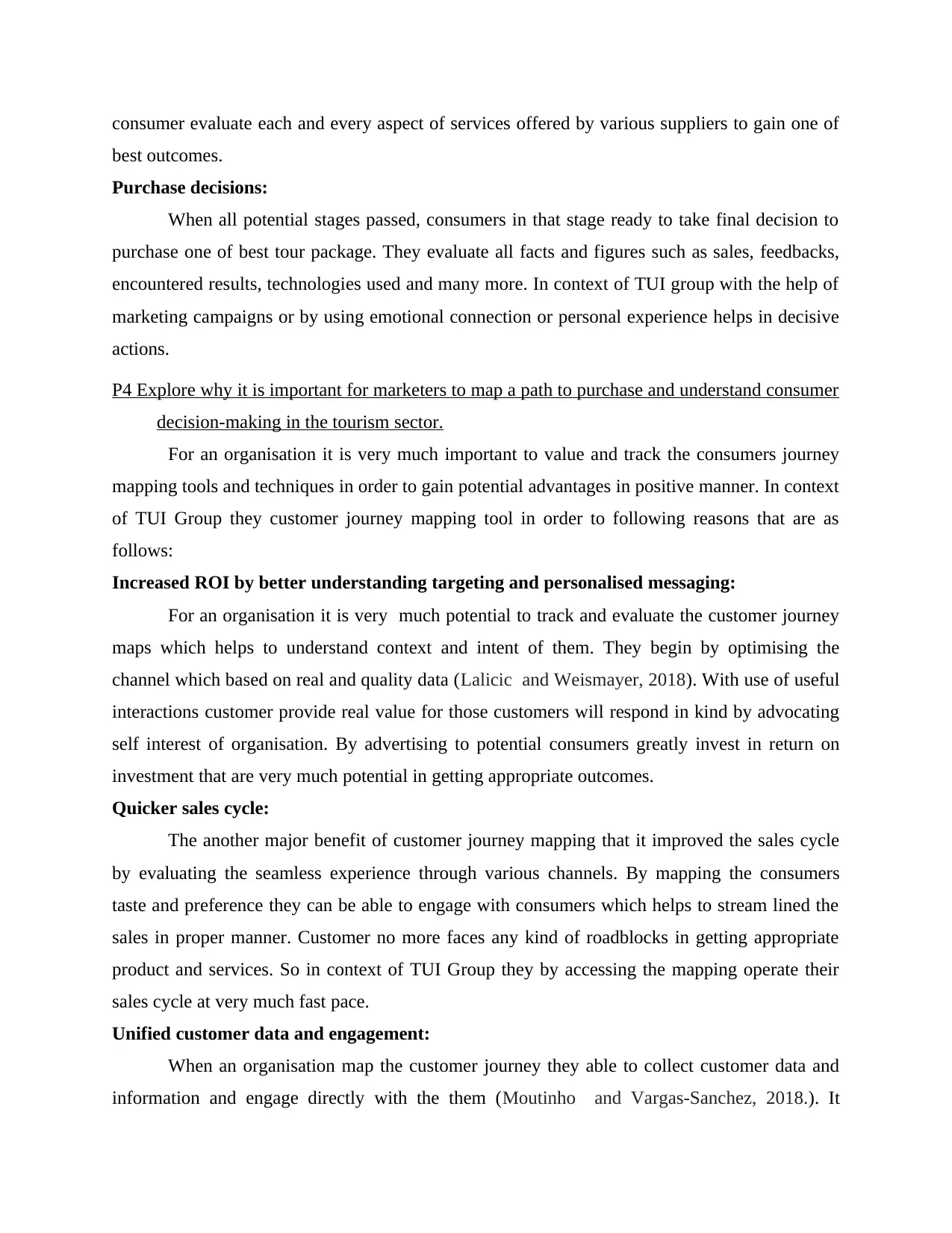
consumer evaluate each and every aspect of services offered by various suppliers to gain one of
best outcomes.
Purchase decisions:
When all potential stages passed, consumers in that stage ready to take final decision to
purchase one of best tour package. They evaluate all facts and figures such as sales, feedbacks,
encountered results, technologies used and many more. In context of TUI group with the help of
marketing campaigns or by using emotional connection or personal experience helps in decisive
actions.
P4 Explore why it is important for marketers to map a path to purchase and understand consumer
decision-making in the tourism sector.
For an organisation it is very much important to value and track the consumers journey
mapping tools and techniques in order to gain potential advantages in positive manner. In context
of TUI Group they customer journey mapping tool in order to following reasons that are as
follows:
Increased ROI by better understanding targeting and personalised messaging:
For an organisation it is very much potential to track and evaluate the customer journey
maps which helps to understand context and intent of them. They begin by optimising the
channel which based on real and quality data (Lalicic and Weismayer, 2018). With use of useful
interactions customer provide real value for those customers will respond in kind by advocating
self interest of organisation. By advertising to potential consumers greatly invest in return on
investment that are very much potential in getting appropriate outcomes.
Quicker sales cycle:
The another major benefit of customer journey mapping that it improved the sales cycle
by evaluating the seamless experience through various channels. By mapping the consumers
taste and preference they can be able to engage with consumers which helps to stream lined the
sales in proper manner. Customer no more faces any kind of roadblocks in getting appropriate
product and services. So in context of TUI Group they by accessing the mapping operate their
sales cycle at very much fast pace.
Unified customer data and engagement:
When an organisation map the customer journey they able to collect customer data and
information and engage directly with the them (Moutinho and Vargas-Sanchez, 2018.). It
best outcomes.
Purchase decisions:
When all potential stages passed, consumers in that stage ready to take final decision to
purchase one of best tour package. They evaluate all facts and figures such as sales, feedbacks,
encountered results, technologies used and many more. In context of TUI group with the help of
marketing campaigns or by using emotional connection or personal experience helps in decisive
actions.
P4 Explore why it is important for marketers to map a path to purchase and understand consumer
decision-making in the tourism sector.
For an organisation it is very much important to value and track the consumers journey
mapping tools and techniques in order to gain potential advantages in positive manner. In context
of TUI Group they customer journey mapping tool in order to following reasons that are as
follows:
Increased ROI by better understanding targeting and personalised messaging:
For an organisation it is very much potential to track and evaluate the customer journey
maps which helps to understand context and intent of them. They begin by optimising the
channel which based on real and quality data (Lalicic and Weismayer, 2018). With use of useful
interactions customer provide real value for those customers will respond in kind by advocating
self interest of organisation. By advertising to potential consumers greatly invest in return on
investment that are very much potential in getting appropriate outcomes.
Quicker sales cycle:
The another major benefit of customer journey mapping that it improved the sales cycle
by evaluating the seamless experience through various channels. By mapping the consumers
taste and preference they can be able to engage with consumers which helps to stream lined the
sales in proper manner. Customer no more faces any kind of roadblocks in getting appropriate
product and services. So in context of TUI Group they by accessing the mapping operate their
sales cycle at very much fast pace.
Unified customer data and engagement:
When an organisation map the customer journey they able to collect customer data and
information and engage directly with the them (Moutinho and Vargas-Sanchez, 2018.). It
Paraphrase This Document
Need a fresh take? Get an instant paraphrase of this document with our AI Paraphraser
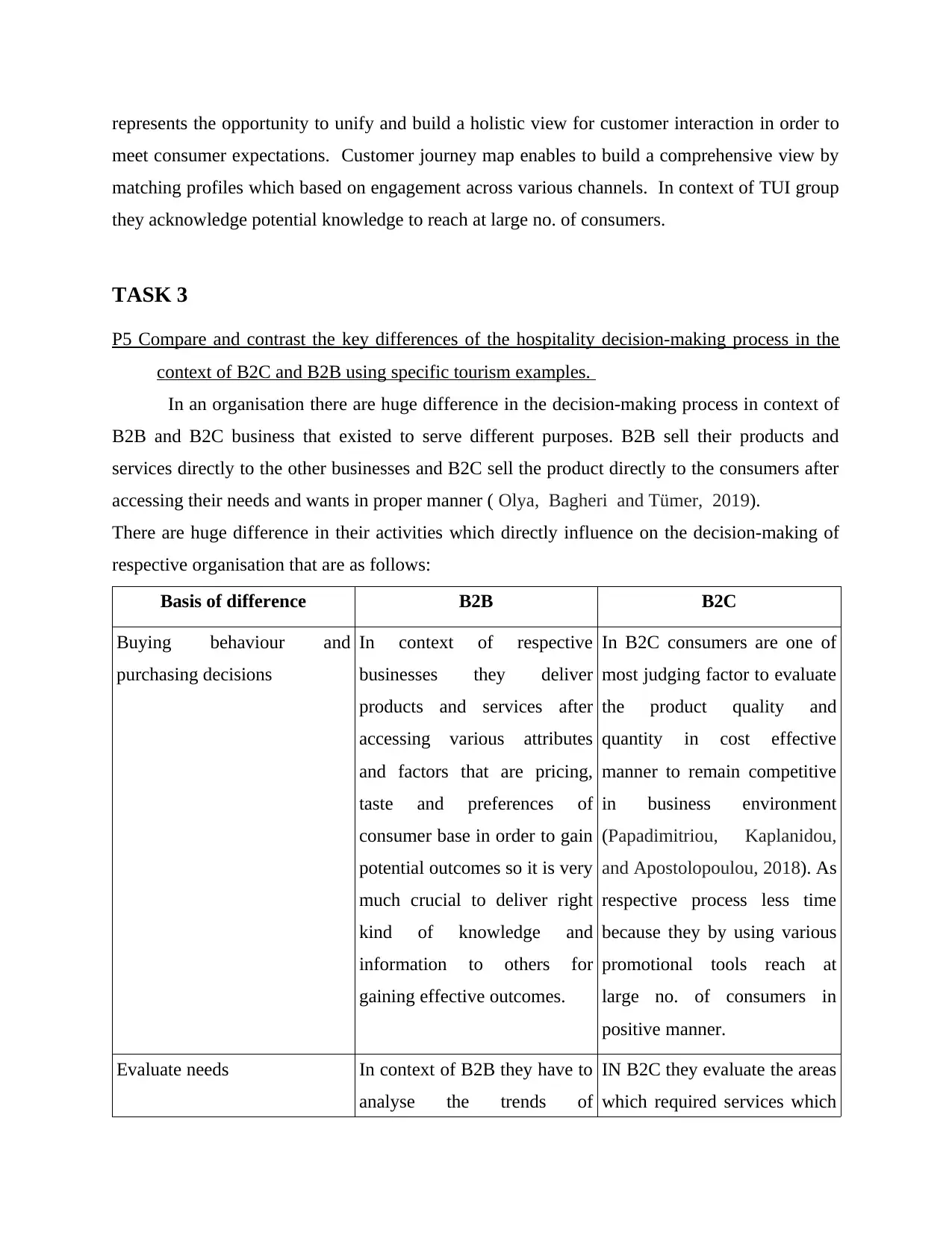
represents the opportunity to unify and build a holistic view for customer interaction in order to
meet consumer expectations. Customer journey map enables to build a comprehensive view by
matching profiles which based on engagement across various channels. In context of TUI group
they acknowledge potential knowledge to reach at large no. of consumers.
TASK 3
P5 Compare and contrast the key differences of the hospitality decision-making process in the
context of B2C and B2B using specific tourism examples.
In an organisation there are huge difference in the decision-making process in context of
B2B and B2C business that existed to serve different purposes. B2B sell their products and
services directly to the other businesses and B2C sell the product directly to the consumers after
accessing their needs and wants in proper manner ( Olya, Bagheri and Tümer, 2019).
There are huge difference in their activities which directly influence on the decision-making of
respective organisation that are as follows:
Basis of difference B2B B2C
Buying behaviour and
purchasing decisions
In context of respective
businesses they deliver
products and services after
accessing various attributes
and factors that are pricing,
taste and preferences of
consumer base in order to gain
potential outcomes so it is very
much crucial to deliver right
kind of knowledge and
information to others for
gaining effective outcomes.
In B2C consumers are one of
most judging factor to evaluate
the product quality and
quantity in cost effective
manner to remain competitive
in business environment
(Papadimitriou, Kaplanidou,
and Apostolopoulou, 2018). As
respective process less time
because they by using various
promotional tools reach at
large no. of consumers in
positive manner.
Evaluate needs In context of B2B they have to
analyse the trends of
IN B2C they evaluate the areas
which required services which
meet consumer expectations. Customer journey map enables to build a comprehensive view by
matching profiles which based on engagement across various channels. In context of TUI group
they acknowledge potential knowledge to reach at large no. of consumers.
TASK 3
P5 Compare and contrast the key differences of the hospitality decision-making process in the
context of B2C and B2B using specific tourism examples.
In an organisation there are huge difference in the decision-making process in context of
B2B and B2C business that existed to serve different purposes. B2B sell their products and
services directly to the other businesses and B2C sell the product directly to the consumers after
accessing their needs and wants in proper manner ( Olya, Bagheri and Tümer, 2019).
There are huge difference in their activities which directly influence on the decision-making of
respective organisation that are as follows:
Basis of difference B2B B2C
Buying behaviour and
purchasing decisions
In context of respective
businesses they deliver
products and services after
accessing various attributes
and factors that are pricing,
taste and preferences of
consumer base in order to gain
potential outcomes so it is very
much crucial to deliver right
kind of knowledge and
information to others for
gaining effective outcomes.
In B2C consumers are one of
most judging factor to evaluate
the product quality and
quantity in cost effective
manner to remain competitive
in business environment
(Papadimitriou, Kaplanidou,
and Apostolopoulou, 2018). As
respective process less time
because they by using various
promotional tools reach at
large no. of consumers in
positive manner.
Evaluate needs In context of B2B they have to
analyse the trends of
IN B2C they evaluate the areas
which required services which
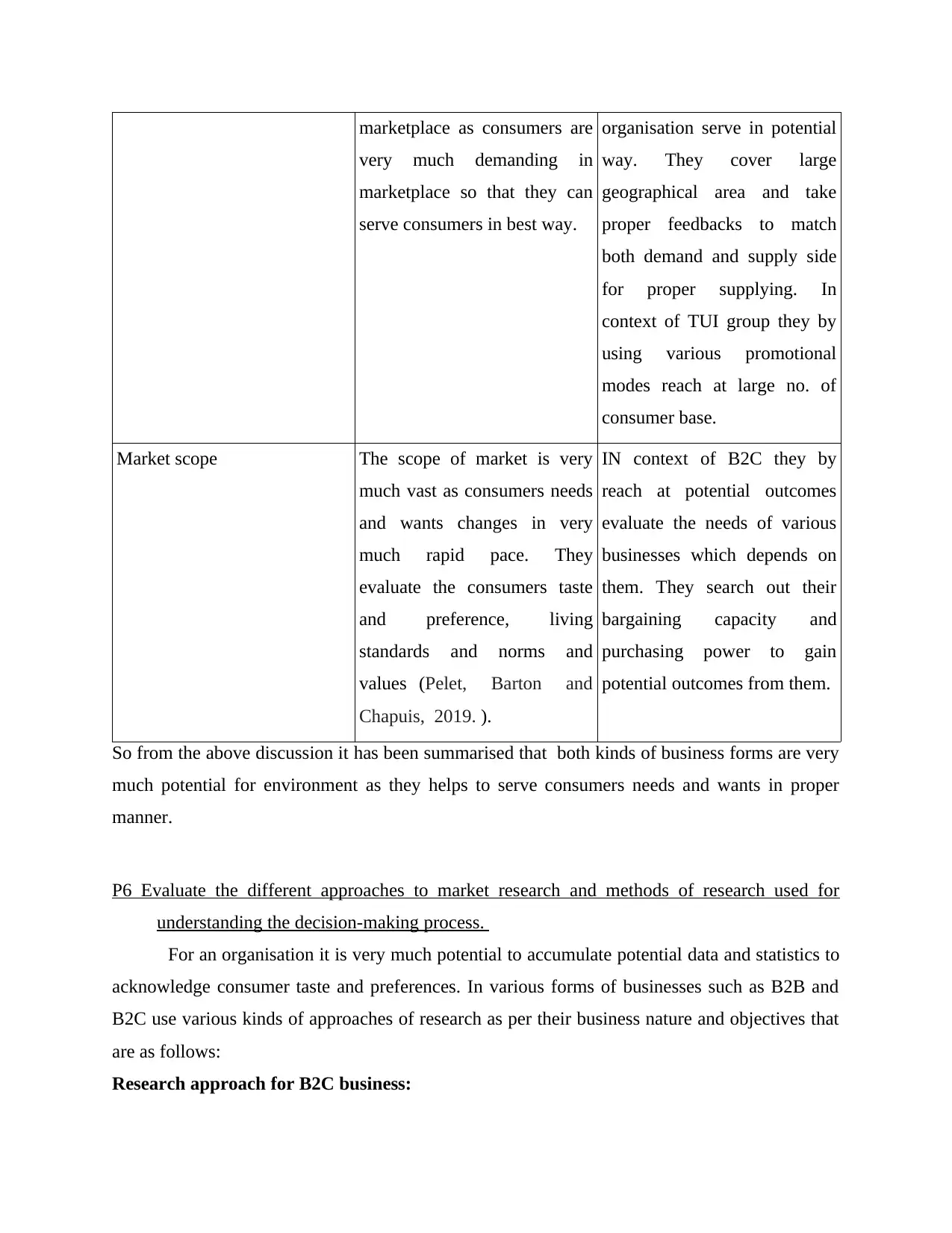
marketplace as consumers are
very much demanding in
marketplace so that they can
serve consumers in best way.
organisation serve in potential
way. They cover large
geographical area and take
proper feedbacks to match
both demand and supply side
for proper supplying. In
context of TUI group they by
using various promotional
modes reach at large no. of
consumer base.
Market scope The scope of market is very
much vast as consumers needs
and wants changes in very
much rapid pace. They
evaluate the consumers taste
and preference, living
standards and norms and
values (Pelet, Barton and
Chapuis, 2019. ).
IN context of B2C they by
reach at potential outcomes
evaluate the needs of various
businesses which depends on
them. They search out their
bargaining capacity and
purchasing power to gain
potential outcomes from them.
So from the above discussion it has been summarised that both kinds of business forms are very
much potential for environment as they helps to serve consumers needs and wants in proper
manner.
P6 Evaluate the different approaches to market research and methods of research used for
understanding the decision-making process.
For an organisation it is very much potential to accumulate potential data and statistics to
acknowledge consumer taste and preferences. In various forms of businesses such as B2B and
B2C use various kinds of approaches of research as per their business nature and objectives that
are as follows:
Research approach for B2C business:
very much demanding in
marketplace so that they can
serve consumers in best way.
organisation serve in potential
way. They cover large
geographical area and take
proper feedbacks to match
both demand and supply side
for proper supplying. In
context of TUI group they by
using various promotional
modes reach at large no. of
consumer base.
Market scope The scope of market is very
much vast as consumers needs
and wants changes in very
much rapid pace. They
evaluate the consumers taste
and preference, living
standards and norms and
values (Pelet, Barton and
Chapuis, 2019. ).
IN context of B2C they by
reach at potential outcomes
evaluate the needs of various
businesses which depends on
them. They search out their
bargaining capacity and
purchasing power to gain
potential outcomes from them.
So from the above discussion it has been summarised that both kinds of business forms are very
much potential for environment as they helps to serve consumers needs and wants in proper
manner.
P6 Evaluate the different approaches to market research and methods of research used for
understanding the decision-making process.
For an organisation it is very much potential to accumulate potential data and statistics to
acknowledge consumer taste and preferences. In various forms of businesses such as B2B and
B2C use various kinds of approaches of research as per their business nature and objectives that
are as follows:
Research approach for B2C business:
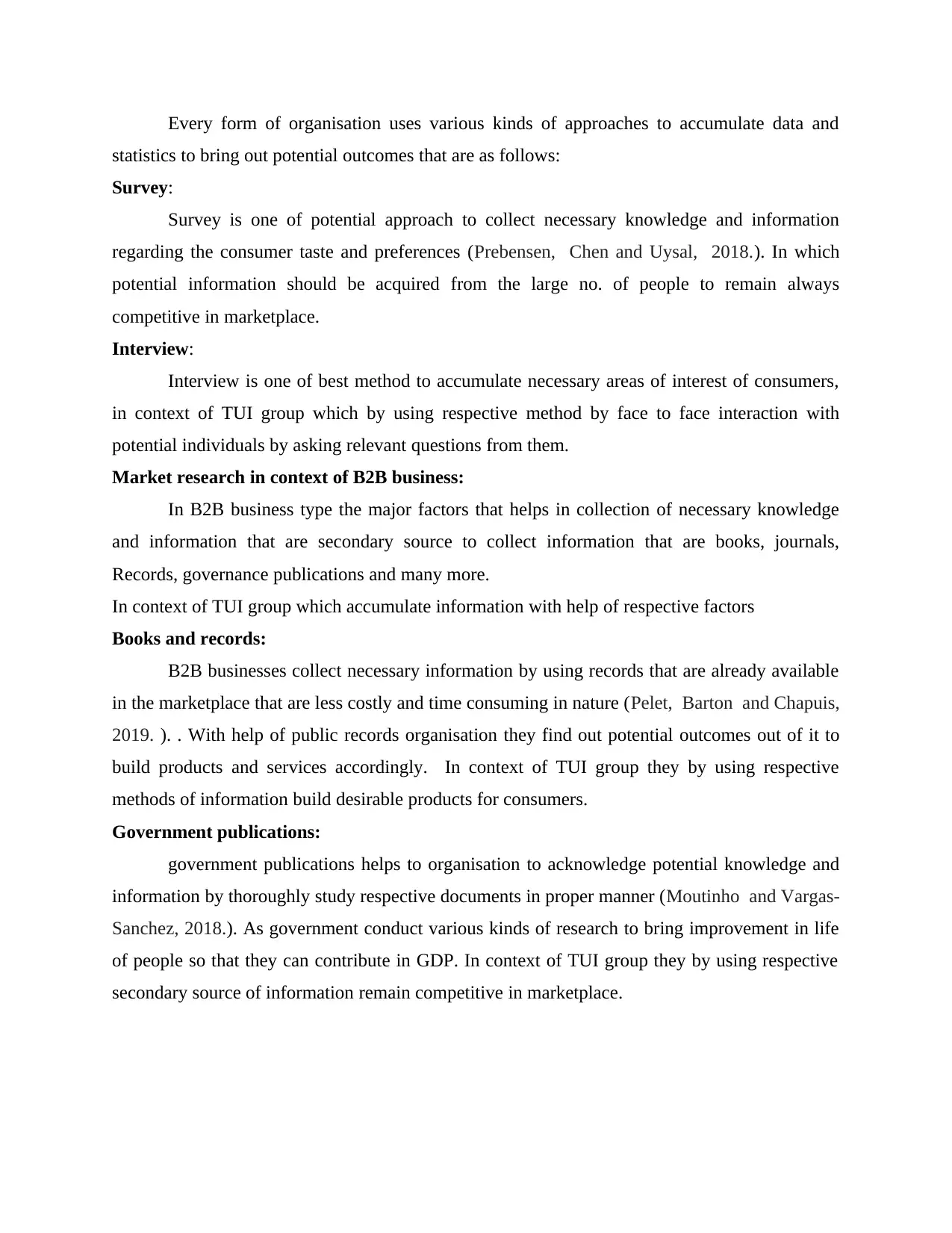
Every form of organisation uses various kinds of approaches to accumulate data and
statistics to bring out potential outcomes that are as follows:
Survey:
Survey is one of potential approach to collect necessary knowledge and information
regarding the consumer taste and preferences (Prebensen, Chen and Uysal, 2018.). In which
potential information should be acquired from the large no. of people to remain always
competitive in marketplace.
Interview:
Interview is one of best method to accumulate necessary areas of interest of consumers,
in context of TUI group which by using respective method by face to face interaction with
potential individuals by asking relevant questions from them.
Market research in context of B2B business:
In B2B business type the major factors that helps in collection of necessary knowledge
and information that are secondary source to collect information that are books, journals,
Records, governance publications and many more.
In context of TUI group which accumulate information with help of respective factors
Books and records:
B2B businesses collect necessary information by using records that are already available
in the marketplace that are less costly and time consuming in nature (Pelet, Barton and Chapuis,
2019. ). . With help of public records organisation they find out potential outcomes out of it to
build products and services accordingly. In context of TUI group they by using respective
methods of information build desirable products for consumers.
Government publications:
government publications helps to organisation to acknowledge potential knowledge and
information by thoroughly study respective documents in proper manner (Moutinho and Vargas-
Sanchez, 2018.). As government conduct various kinds of research to bring improvement in life
of people so that they can contribute in GDP. In context of TUI group they by using respective
secondary source of information remain competitive in marketplace.
statistics to bring out potential outcomes that are as follows:
Survey:
Survey is one of potential approach to collect necessary knowledge and information
regarding the consumer taste and preferences (Prebensen, Chen and Uysal, 2018.). In which
potential information should be acquired from the large no. of people to remain always
competitive in marketplace.
Interview:
Interview is one of best method to accumulate necessary areas of interest of consumers,
in context of TUI group which by using respective method by face to face interaction with
potential individuals by asking relevant questions from them.
Market research in context of B2B business:
In B2B business type the major factors that helps in collection of necessary knowledge
and information that are secondary source to collect information that are books, journals,
Records, governance publications and many more.
In context of TUI group which accumulate information with help of respective factors
Books and records:
B2B businesses collect necessary information by using records that are already available
in the marketplace that are less costly and time consuming in nature (Pelet, Barton and Chapuis,
2019. ). . With help of public records organisation they find out potential outcomes out of it to
build products and services accordingly. In context of TUI group they by using respective
methods of information build desirable products for consumers.
Government publications:
government publications helps to organisation to acknowledge potential knowledge and
information by thoroughly study respective documents in proper manner (Moutinho and Vargas-
Sanchez, 2018.). As government conduct various kinds of research to bring improvement in life
of people so that they can contribute in GDP. In context of TUI group they by using respective
secondary source of information remain competitive in marketplace.
Secure Best Marks with AI Grader
Need help grading? Try our AI Grader for instant feedback on your assignments.
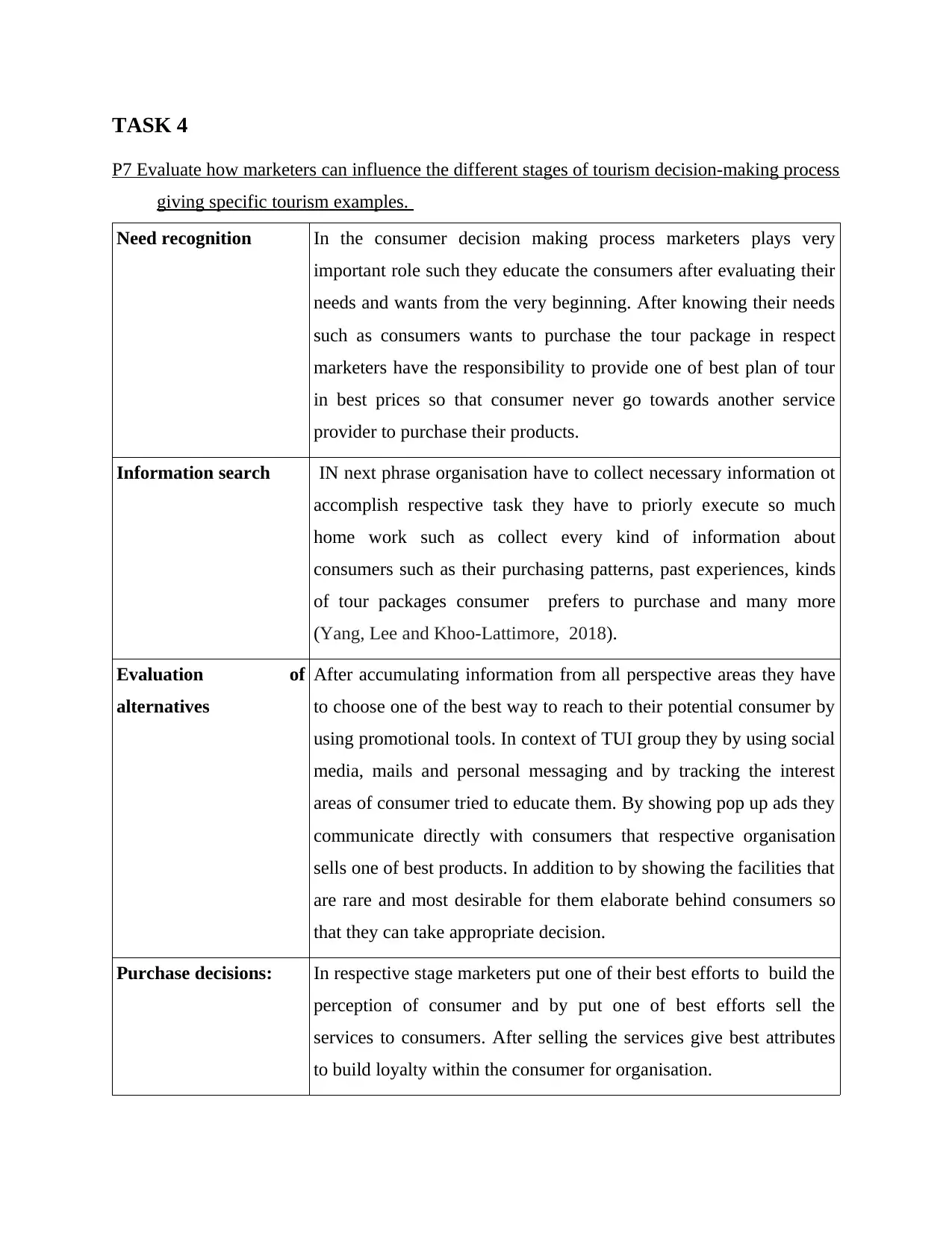
TASK 4
P7 Evaluate how marketers can influence the different stages of tourism decision-making process
giving specific tourism examples.
Need recognition In the consumer decision making process marketers plays very
important role such they educate the consumers after evaluating their
needs and wants from the very beginning. After knowing their needs
such as consumers wants to purchase the tour package in respect
marketers have the responsibility to provide one of best plan of tour
in best prices so that consumer never go towards another service
provider to purchase their products.
Information search IN next phrase organisation have to collect necessary information ot
accomplish respective task they have to priorly execute so much
home work such as collect every kind of information about
consumers such as their purchasing patterns, past experiences, kinds
of tour packages consumer prefers to purchase and many more
(Yang, Lee and Khoo-Lattimore, 2018).
Evaluation of
alternatives
After accumulating information from all perspective areas they have
to choose one of the best way to reach to their potential consumer by
using promotional tools. In context of TUI group they by using social
media, mails and personal messaging and by tracking the interest
areas of consumer tried to educate them. By showing pop up ads they
communicate directly with consumers that respective organisation
sells one of best products. In addition to by showing the facilities that
are rare and most desirable for them elaborate behind consumers so
that they can take appropriate decision.
Purchase decisions: In respective stage marketers put one of their best efforts to build the
perception of consumer and by put one of best efforts sell the
services to consumers. After selling the services give best attributes
to build loyalty within the consumer for organisation.
P7 Evaluate how marketers can influence the different stages of tourism decision-making process
giving specific tourism examples.
Need recognition In the consumer decision making process marketers plays very
important role such they educate the consumers after evaluating their
needs and wants from the very beginning. After knowing their needs
such as consumers wants to purchase the tour package in respect
marketers have the responsibility to provide one of best plan of tour
in best prices so that consumer never go towards another service
provider to purchase their products.
Information search IN next phrase organisation have to collect necessary information ot
accomplish respective task they have to priorly execute so much
home work such as collect every kind of information about
consumers such as their purchasing patterns, past experiences, kinds
of tour packages consumer prefers to purchase and many more
(Yang, Lee and Khoo-Lattimore, 2018).
Evaluation of
alternatives
After accumulating information from all perspective areas they have
to choose one of the best way to reach to their potential consumer by
using promotional tools. In context of TUI group they by using social
media, mails and personal messaging and by tracking the interest
areas of consumer tried to educate them. By showing pop up ads they
communicate directly with consumers that respective organisation
sells one of best products. In addition to by showing the facilities that
are rare and most desirable for them elaborate behind consumers so
that they can take appropriate decision.
Purchase decisions: In respective stage marketers put one of their best efforts to build the
perception of consumer and by put one of best efforts sell the
services to consumers. After selling the services give best attributes
to build loyalty within the consumer for organisation.
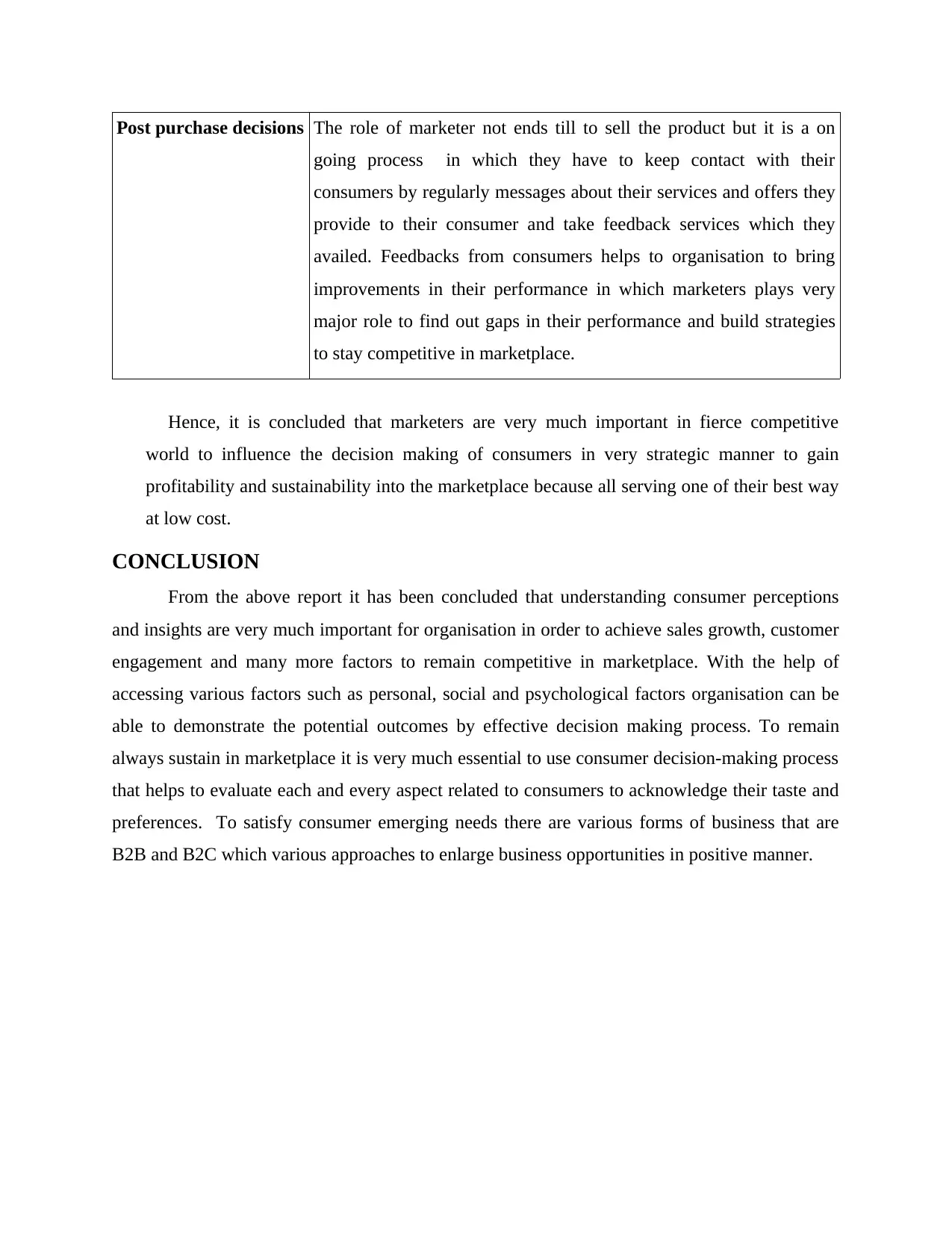
Post purchase decisions The role of marketer not ends till to sell the product but it is a on
going process in which they have to keep contact with their
consumers by regularly messages about their services and offers they
provide to their consumer and take feedback services which they
availed. Feedbacks from consumers helps to organisation to bring
improvements in their performance in which marketers plays very
major role to find out gaps in their performance and build strategies
to stay competitive in marketplace.
Hence, it is concluded that marketers are very much important in fierce competitive
world to influence the decision making of consumers in very strategic manner to gain
profitability and sustainability into the marketplace because all serving one of their best way
at low cost.
CONCLUSION
From the above report it has been concluded that understanding consumer perceptions
and insights are very much important for organisation in order to achieve sales growth, customer
engagement and many more factors to remain competitive in marketplace. With the help of
accessing various factors such as personal, social and psychological factors organisation can be
able to demonstrate the potential outcomes by effective decision making process. To remain
always sustain in marketplace it is very much essential to use consumer decision-making process
that helps to evaluate each and every aspect related to consumers to acknowledge their taste and
preferences. To satisfy consumer emerging needs there are various forms of business that are
B2B and B2C which various approaches to enlarge business opportunities in positive manner.
going process in which they have to keep contact with their
consumers by regularly messages about their services and offers they
provide to their consumer and take feedback services which they
availed. Feedbacks from consumers helps to organisation to bring
improvements in their performance in which marketers plays very
major role to find out gaps in their performance and build strategies
to stay competitive in marketplace.
Hence, it is concluded that marketers are very much important in fierce competitive
world to influence the decision making of consumers in very strategic manner to gain
profitability and sustainability into the marketplace because all serving one of their best way
at low cost.
CONCLUSION
From the above report it has been concluded that understanding consumer perceptions
and insights are very much important for organisation in order to achieve sales growth, customer
engagement and many more factors to remain competitive in marketplace. With the help of
accessing various factors such as personal, social and psychological factors organisation can be
able to demonstrate the potential outcomes by effective decision making process. To remain
always sustain in marketplace it is very much essential to use consumer decision-making process
that helps to evaluate each and every aspect related to consumers to acknowledge their taste and
preferences. To satisfy consumer emerging needs there are various forms of business that are
B2B and B2C which various approaches to enlarge business opportunities in positive manner.
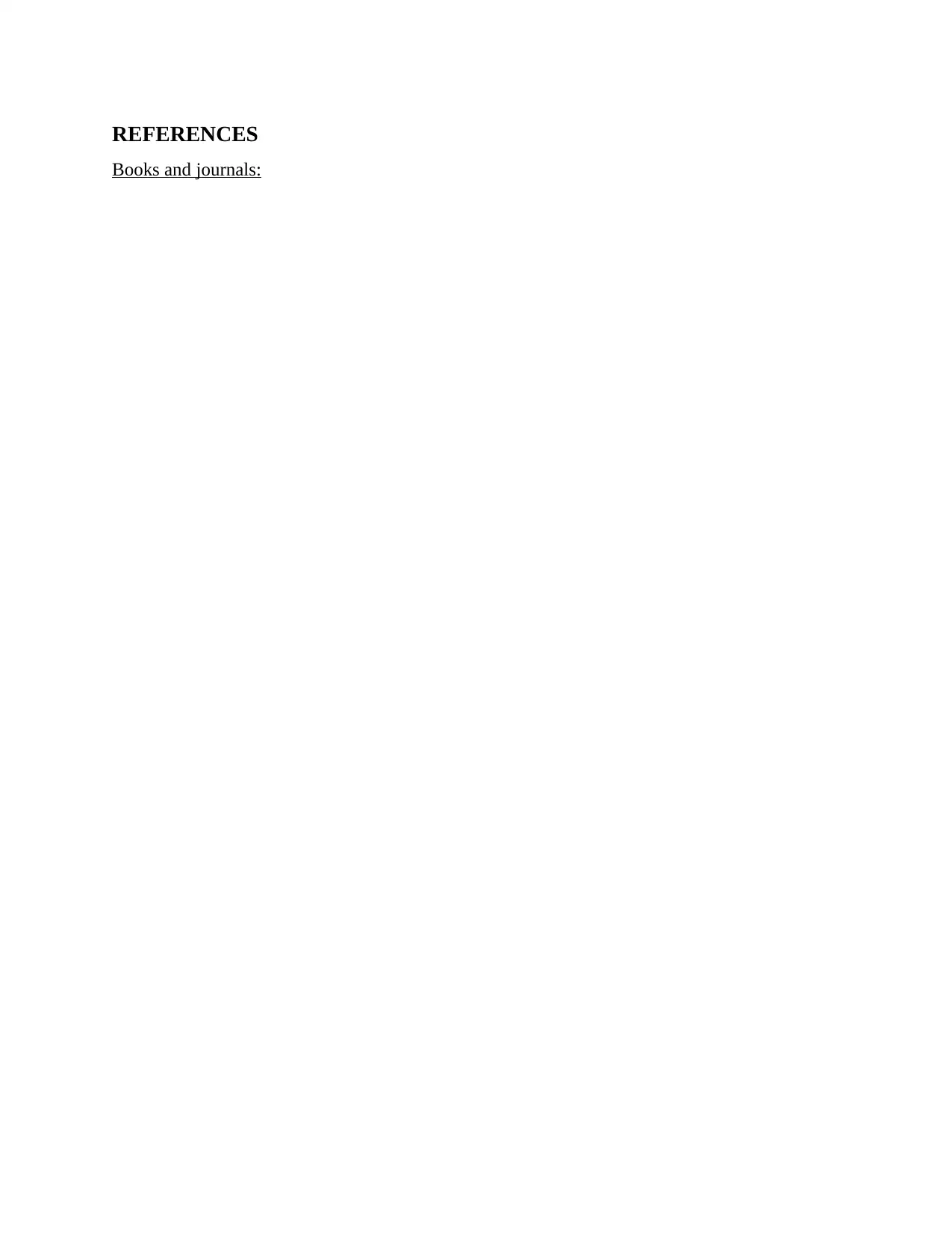
REFERENCES
Books and journals:
Books and journals:
Paraphrase This Document
Need a fresh take? Get an instant paraphrase of this document with our AI Paraphraser
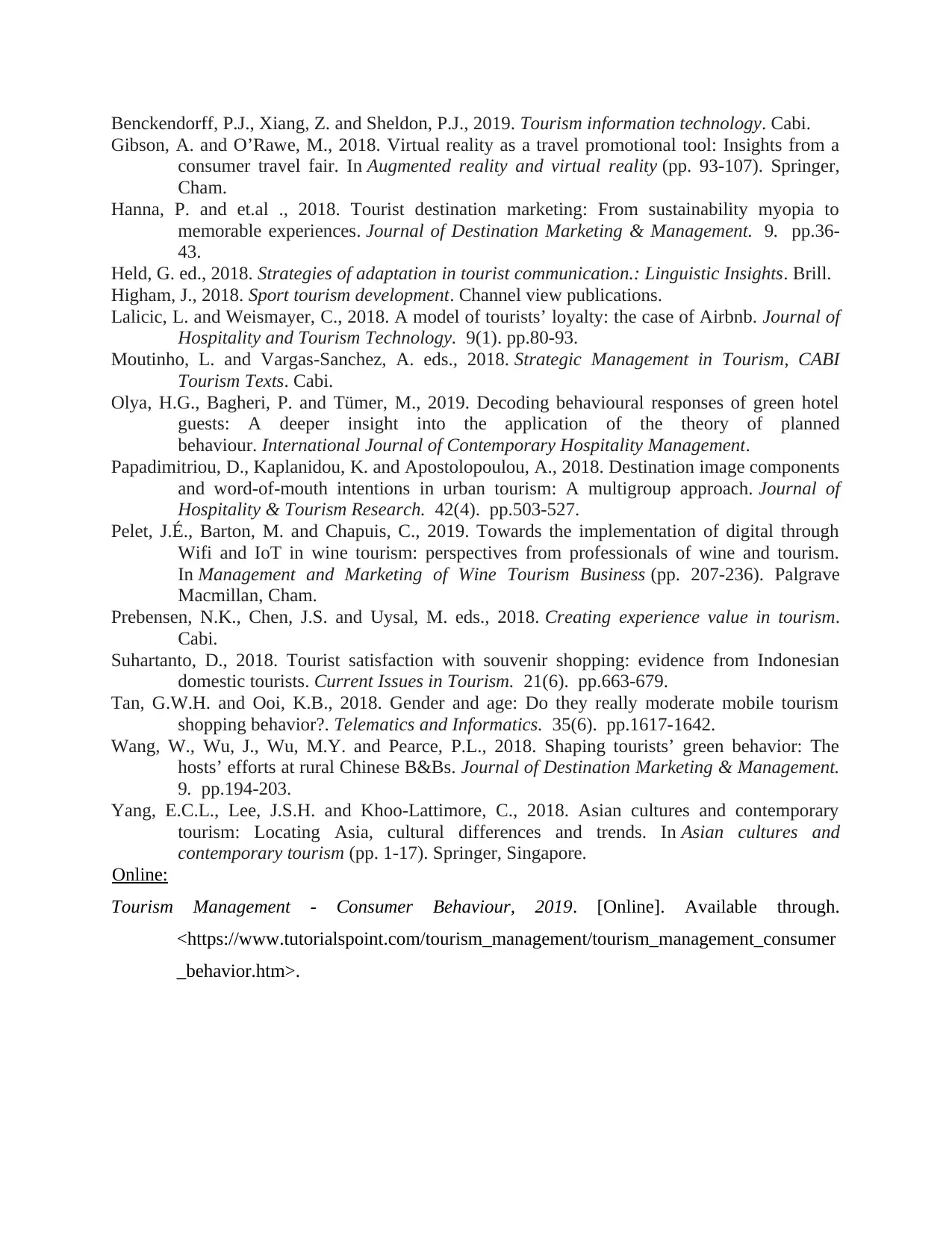
Benckendorff, P.J., Xiang, Z. and Sheldon, P.J., 2019. Tourism information technology. Cabi.
Gibson, A. and O’Rawe, M., 2018. Virtual reality as a travel promotional tool: Insights from a
consumer travel fair. In Augmented reality and virtual reality (pp. 93-107). Springer,
Cham.
Hanna, P. and et.al ., 2018. Tourist destination marketing: From sustainability myopia to
memorable experiences. Journal of Destination Marketing & Management. 9. pp.36-
43.
Held, G. ed., 2018. Strategies of adaptation in tourist communication.: Linguistic Insights. Brill.
Higham, J., 2018. Sport tourism development. Channel view publications.
Lalicic, L. and Weismayer, C., 2018. A model of tourists’ loyalty: the case of Airbnb. Journal of
Hospitality and Tourism Technology. 9(1). pp.80-93.
Moutinho, L. and Vargas-Sanchez, A. eds., 2018. Strategic Management in Tourism, CABI
Tourism Texts. Cabi.
Olya, H.G., Bagheri, P. and Tümer, M., 2019. Decoding behavioural responses of green hotel
guests: A deeper insight into the application of the theory of planned
behaviour. International Journal of Contemporary Hospitality Management.
Papadimitriou, D., Kaplanidou, K. and Apostolopoulou, A., 2018. Destination image components
and word-of-mouth intentions in urban tourism: A multigroup approach. Journal of
Hospitality & Tourism Research. 42(4). pp.503-527.
Pelet, J.É., Barton, M. and Chapuis, C., 2019. Towards the implementation of digital through
Wifi and IoT in wine tourism: perspectives from professionals of wine and tourism.
In Management and Marketing of Wine Tourism Business (pp. 207-236). Palgrave
Macmillan, Cham.
Prebensen, N.K., Chen, J.S. and Uysal, M. eds., 2018. Creating experience value in tourism.
Cabi.
Suhartanto, D., 2018. Tourist satisfaction with souvenir shopping: evidence from Indonesian
domestic tourists. Current Issues in Tourism. 21(6). pp.663-679.
Tan, G.W.H. and Ooi, K.B., 2018. Gender and age: Do they really moderate mobile tourism
shopping behavior?. Telematics and Informatics. 35(6). pp.1617-1642.
Wang, W., Wu, J., Wu, M.Y. and Pearce, P.L., 2018. Shaping tourists’ green behavior: The
hosts’ efforts at rural Chinese B&Bs. Journal of Destination Marketing & Management.
9. pp.194-203.
Yang, E.C.L., Lee, J.S.H. and Khoo-Lattimore, C., 2018. Asian cultures and contemporary
tourism: Locating Asia, cultural differences and trends. In Asian cultures and
contemporary tourism (pp. 1-17). Springer, Singapore.
Online:
Tourism Management - Consumer Behaviour, 2019. [Online]. Available through.
<https://www.tutorialspoint.com/tourism_management/tourism_management_consumer
_behavior.htm>.
Gibson, A. and O’Rawe, M., 2018. Virtual reality as a travel promotional tool: Insights from a
consumer travel fair. In Augmented reality and virtual reality (pp. 93-107). Springer,
Cham.
Hanna, P. and et.al ., 2018. Tourist destination marketing: From sustainability myopia to
memorable experiences. Journal of Destination Marketing & Management. 9. pp.36-
43.
Held, G. ed., 2018. Strategies of adaptation in tourist communication.: Linguistic Insights. Brill.
Higham, J., 2018. Sport tourism development. Channel view publications.
Lalicic, L. and Weismayer, C., 2018. A model of tourists’ loyalty: the case of Airbnb. Journal of
Hospitality and Tourism Technology. 9(1). pp.80-93.
Moutinho, L. and Vargas-Sanchez, A. eds., 2018. Strategic Management in Tourism, CABI
Tourism Texts. Cabi.
Olya, H.G., Bagheri, P. and Tümer, M., 2019. Decoding behavioural responses of green hotel
guests: A deeper insight into the application of the theory of planned
behaviour. International Journal of Contemporary Hospitality Management.
Papadimitriou, D., Kaplanidou, K. and Apostolopoulou, A., 2018. Destination image components
and word-of-mouth intentions in urban tourism: A multigroup approach. Journal of
Hospitality & Tourism Research. 42(4). pp.503-527.
Pelet, J.É., Barton, M. and Chapuis, C., 2019. Towards the implementation of digital through
Wifi and IoT in wine tourism: perspectives from professionals of wine and tourism.
In Management and Marketing of Wine Tourism Business (pp. 207-236). Palgrave
Macmillan, Cham.
Prebensen, N.K., Chen, J.S. and Uysal, M. eds., 2018. Creating experience value in tourism.
Cabi.
Suhartanto, D., 2018. Tourist satisfaction with souvenir shopping: evidence from Indonesian
domestic tourists. Current Issues in Tourism. 21(6). pp.663-679.
Tan, G.W.H. and Ooi, K.B., 2018. Gender and age: Do they really moderate mobile tourism
shopping behavior?. Telematics and Informatics. 35(6). pp.1617-1642.
Wang, W., Wu, J., Wu, M.Y. and Pearce, P.L., 2018. Shaping tourists’ green behavior: The
hosts’ efforts at rural Chinese B&Bs. Journal of Destination Marketing & Management.
9. pp.194-203.
Yang, E.C.L., Lee, J.S.H. and Khoo-Lattimore, C., 2018. Asian cultures and contemporary
tourism: Locating Asia, cultural differences and trends. In Asian cultures and
contemporary tourism (pp. 1-17). Springer, Singapore.
Online:
Tourism Management - Consumer Behaviour, 2019. [Online]. Available through.
<https://www.tutorialspoint.com/tourism_management/tourism_management_consumer
_behavior.htm>.
1 out of 14
Related Documents
Your All-in-One AI-Powered Toolkit for Academic Success.
+13062052269
info@desklib.com
Available 24*7 on WhatsApp / Email
![[object Object]](/_next/static/media/star-bottom.7253800d.svg)
Unlock your academic potential
© 2024 | Zucol Services PVT LTD | All rights reserved.





